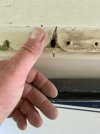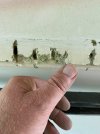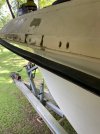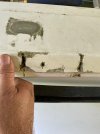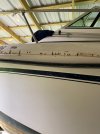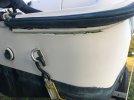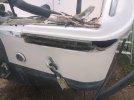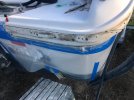The damage is severe but as long as the 'flap' between the two open cracks is sturdy and doesn't flex, a cheap fix can be done. Just make sure the cap is tight to the hull and doesn't move when lifted or pressed.
Since the major damage is under the rub rail, you can patch with MarineTex or a structural filler as mentioned but the MarineTex will work and is fairly thick so it is less likely to sag.Yoy may need to put some sort of backer in the holes and that can be as simple as a small piece of fiberglass cloth with a thread inserted in the middle to give a way to hold the cloth 'tight'. You can apply some resin to the cloth first to help it stick (on the backside of the crack). Let it set for 30 minutes or so or until firm but not fully cured and then snip off the thread and partially fill with MarineTex (or polyester resin with a filler). When all the cracks are done you should caulk the seam with something like Sikaflex or LifeSeal. I would also fill the screw holes with some resin or MarineTex since they may not hold the rub rain screws well. Even if you don't fill the holes, you should shoot some caulk/sealant into the holes prior to rescrewing the rail molding.


